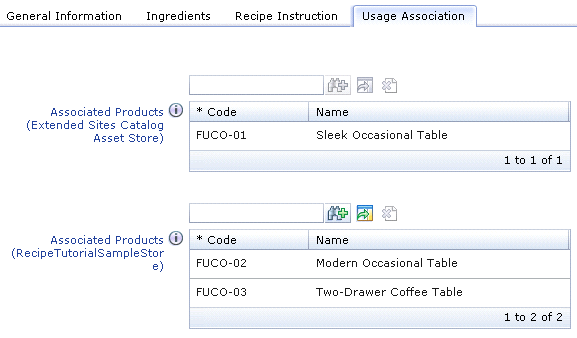Tutorial: Supporting extended sites in a Management Center tool for a custom object
WebSphere Commerce supports the extended sites business model, where a seller can have many sites aimed at different audiences. For example, a seller may create sites based on geographical regions, whereas some customized sites are created for individual large merchants. All these different sites can share assets such as the catalog, whereby each site selects the subset of the catalog that are represented and adjusts the prices or other features as necessary. The extended sites business model supports businesses using multiple strategies to make its products available. Each site appears unique to the users that access it and each site can implement business rules unique to that site.
- Extended sites
- Extended sites information model
- A WebSphere Support Technical Exchange presentation: Extended Sites Business Model in WebSphere Commerce
In this tutorial, you will remodel the Recipes tool with support for extended sites. The customization in this tutorial is usually performed in conjunction with the tasks in the Adding a Recipes tool to the Management Center tutorial; however, the Recipes scenario introduces these concepts separately. The sample extended site store that you previously created will be used in your recipe customization. Due to the scope of this effort, you perform only the key steps and points in each lesson.
The following diagram shows the user interface changes that you will make in this tutorial. On the left side of the diagram, the user interface for Usage Association , which are the associations between Recipes and Catalog Entries, is shown, when you have completed Tutorial: Adding a tool to the Management Center. On the right side of the diagram, the extended site representation of the same interface is shown. The Usage Association table is split into two tables; the one on top displays the usage associations that are inherited from and owned by the asset store and the one at the bottom displays the usage associations that are owned by the current store (local usage associations).
| Before customization | With extended sites |
|---|---|
 |
 |
Learning objectives
- List view and the properties view definitions.
- Business object definitions.
- Change Management Center definitions to support extended sites store
- Change Management Center view definitions, such as the properties views and list views to support extended sites store.
- Change JavaServer Pages (JSP) files to support extended sites store.
Time required
Expect this tutorial to take five hours to complete. This tutorial will take longer if you explore concepts related to this tutorial.Skill level
This tutorial is intended for advanced WebSphere Commerce developers that are responsible for creating and customizing the Management Center user interface in an extended sites model. To complete the tutorial you should be familiar with the following terms and concepts:- Extended sites
- WebSphere Commerce services
- Management Center framework
- Web services
- Access control
- XML
- SQL
- OpenLaszlo
- Rational Application Developer
- JSP files
System requirements
Before beginning this tutorial, ensure that you have completed the following tasks:
- Install WebSphere Commerce Developer Version 7
- Complete the Creating the Recipe BOD services module tutorial.
- Complete the Adding a Recipes tool for the Management Center tutorial.
Tutorial resources
To complete this tutorial, the following resources are used. Ensure you have downloaded and extracted any zip files containing required code samples to a temporary directory, such as C:\Temp before beginning this tutorial:

 Download
the completed tutorial code for WebSphere Commerce Version
7 and Feature Pack 1.
Download
the completed tutorial code for WebSphere Commerce Version
7 and Feature Pack 1.
 Download
the completed tutorial code for WebSphere Commerce Version
7 Feature Pack 2.
Download
the completed tutorial code for WebSphere Commerce Version
7 Feature Pack 2.